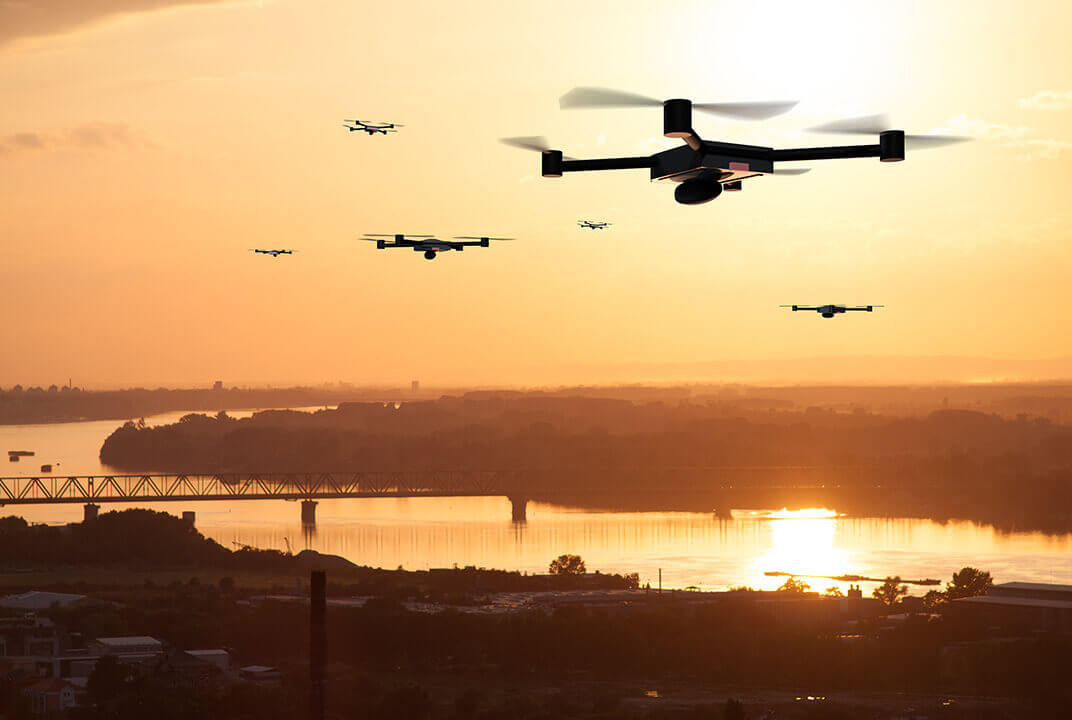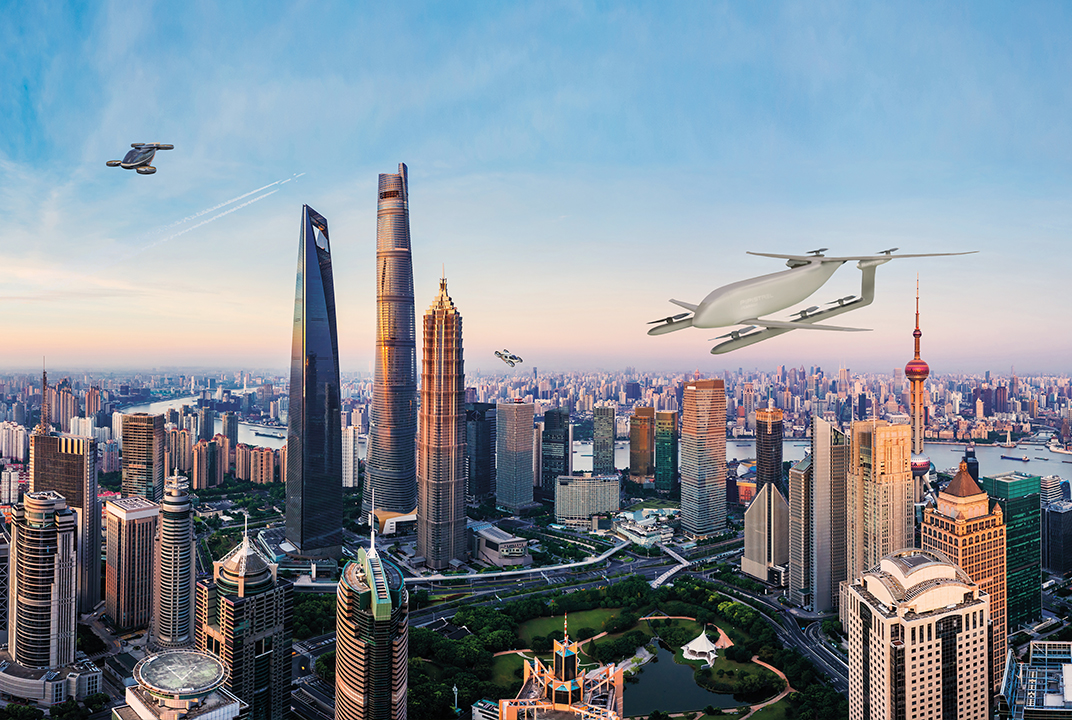Commercial UAVs have potential to halve CO2 emissions for freight deliveries, finds new report by Inmarsat and Cranfield University
Aviation
‘UAVs: Unlocking positive transformation in the world’ highlights an unprecedented opportunity to reduce urban freight transport’s environmental impact by using drones.
Commercial unmanned aerial vehicles (UAVs) have the potential to almost halve the carbon dioxide (CO2) emissions of urban freight transport compared to small light commercial vehicles (LCVs), providing an unprecedented opportunity for the logistics industry to reduce its environmental impact. This is just one of the breakthrough findings from a brand new report published today by Inmarsat, the world leader in global, mobile satellite communications, and Cranfield University, examining the wealth of new possibilities and applications unlocked by commercial UAVs.
As part of the report, ‘UAVs: Unlocking positive transformation in the world’, Cranfield University used its own modelling and primary data resources to compare the CO2 emissions emitted by UAVs and LCVs. An LCV delivering 10 similar sized packages per 8-hour shift over a 5km delivery radius, and following a regular schedule of consecutive deliveries, produces an estimated CO2 emission rate of 3,394 grams per 24 hours (3 shifts). In contrast, a large-sized UAV with a 50kg payload operating in the same delivery protocol as the LCV produces 1,800 grams of emissions per 24 hours, a 47% reduction.
Alternatively, a medium-sized UAV with a 36km range, carrying a 5kg payload under less-than-optimal operating pattern (making separate individual journeys from the central warehouse rather than making consecutive deliveries) was estimated to produce 2,160 grams of carbon dioxide emissions over 24 hours – a significant reduction of 36% compared to the equivalent LCV road transport.
The report, which analyses both new and existing research, also identifies the many other commercial advantages provided by UAVs to organisations that embrace the technology and adopt new operational methods, with cost and time savings leading to enhanced supply chain and business efficiencies. In addition, it explores the considerable benefits that extend beyond those driven by commercial gain, such as delivering humanitarian and medical aid to remote communities and conflict zones, surveillance to protect endangered animals from poachers and monitoring for illegal deforestation or mining operations.
Professor Dame Helen Atkinson DBE FREng, Cranfield University’s Pro-Vice-Chancellor of the School of Aerospace, Transport and Manufacturing, said: “Commercial UAVs have the potential to transform our world in a range of safe and environmentally friendly ways. This report is an important step in harnessing the power of UAVs and unlocking the opportunities they offer to advance air transport activities and services with fast and efficient delivery of goods.”
Over the next seven years, the commercial UAV market is projected to increase from $2.32 billion in 2021 to $11.29 billion in 2028, marking a compound annual growth rate (CAGR) of 25.39% during this period[1]. Despite this positive outlook, the new report also recognises the regulatory challenges in allowing UAVs to fly beyond visual line of sight (BVLOS) and integrate with other air traffic, as well as the need for well-structured regulation that defines the roles and responsibilities of all stakeholders that utilise airspace.
Anthony Spouncer, Inmarsat’s Senior Director of UAVs and Unmanned Traffic Management (UTM), said: “Our new report with Cranfield University is packed with valuable insights that reinforce the positive and far-reaching impact of commercial UAVs on numerous aspects of society and business. However, it’s also clear that unless autonomous vehicles and unmanned aviation are safely and securely integrated into managed airspace, their true potential cannot be unlocked on a commercial scale.
“Inmarsat is uniquely placed to deliver airspace integration with our recently launched Velaris UAV connectivity solution, working side-by-side with global regulators, air navigation service providers, UAV operators and an international partner network. Powered by our global ELERA L-band satellite network, Velaris will deliver new digital automation capabilities, allowing operators to send drones on long distance flights and access applications, including real-time monitoring, to ensure safe integration with other air traffic users. As the UAV industry evolves, so will Velaris, thanks to our fully-funded technology roadmap.”
Inmarsat and Cranfield University’s report, ‘UAVs: Unlocking positive transformation in the world’, is available to download here.
[1] Fortune Business Insights Commercial Drone Market, 2021-2028
FURTHER INFORMATION
About Inmarsat
Inmarsat is the world leader in global, mobile satellite communications. It owns and operates the world’s most diverse global portfolio of mobile telecommunications satellite networks, and holds a multi-layered, global spectrum portfolio, covering L-band, Ka-band and S-band, enabling unparalleled breadth and diversity in the solutions it provides. Inmarsat’s long-established global distribution network includes not only the world’s leading channel partners but also its own strong direct retail capabilities, enabling end to end customer service assurance.
The company has an unrivalled track record of operating the world’s most reliable global mobile satellite telecommunications networks, sustaining business and mission critical safety & operational applications for more than 40 years. It is also a major driving force behind technological innovation in mobile satellite communications, sustaining its leadership through a substantial investment and a powerful network of technology and manufacturing partners.
Inmarsat operates across a diversified portfolio of sectors with the financial resources to fund its business strategy and holds leading positions in the Maritime, Government, Aviation and Enterprise satcoms markets, operating consistently as a trusted, responsive and high-quality partner to its customers across the globe.
For further information, follow us: Twitter | LinkedIn | Facebook | YouTube | Instagram.
Media contacts
Jonathan Sinnatt/Matthew Knowles
Corporate Communications
Tel: +44 (0) 7889 605 272 / +44 (0) 7725 475 507
press@inmarsat.com
Robeel Haq
Head of Communications, Inmarsat Aviation
+44 (0)20 7728 1352
robeel.haq@inmarsat.com
About Cranfield University
Cranfield is a specialist postgraduate university that is a global leader for education and transformational research in technology and management.
Cranfield has over 50 years’ experience in transport, including the aviation, automotive, motorsport, military and marine sectors. We are one of the few universities in the world to have its own airport – our global research airport offers a unique environment for transformational research.
Our education and award-winning research covers all modes of vehicles and transport across technology, engineering and management, including sustainable transport and intelligent mobility.
In an increasingly interconnected world, we specialise in understanding the whole environment in which transport operates: the vehicles, infrastructure, businesses and logistics, as well as the human aspects of operating, managing and using transport.
Our world-class facilities include high-performance wind tunnels, an off-road vehicle dynamics facility, a crash impact test centre (one of just two FIA (Federation Internationale de l’Automobile) approved test centres in the world) and our accident investigation laboratory, which is dedicated to our work in aviation, marine and rail safety and the only accident investigation laboratory of its type outside the United States.
We were awarded the Queen’s Anniversary Prize for our world-leading work in aviation safety through research and training in air accident investigation in 2011 and in 2019 for delivering in-flight aerospace engineering training for the worldwide aviation industry through our National Flying Laboratory Centre’s flying classrooms and laboratories.
Our Multi-User Environment for Autonomous Vehicle Innovation is a £9 million ‘smart’ roadway test environment for the development of intelligent and autonomous vehicles, the first of its kind in the UK next to an airport and within the controlled setting of a university campus. It includes the associated systems needed to integrate emerging technologies into our day-to-day lives.
A new £65 million Digital Aviation Research and Technology Centre at Cranfield is spearheading the UK’s research into digital aviation technology. In 2018, Cranfield Airport became the first in the UK to have an operational digital air traffic control centre, replicating what can be seen through the windows of a traditional air traffic control tower via a live feed using HD cameras and sensors.
Media contacts
Cranfield University
mediarelations@cranfield.ac.uk

